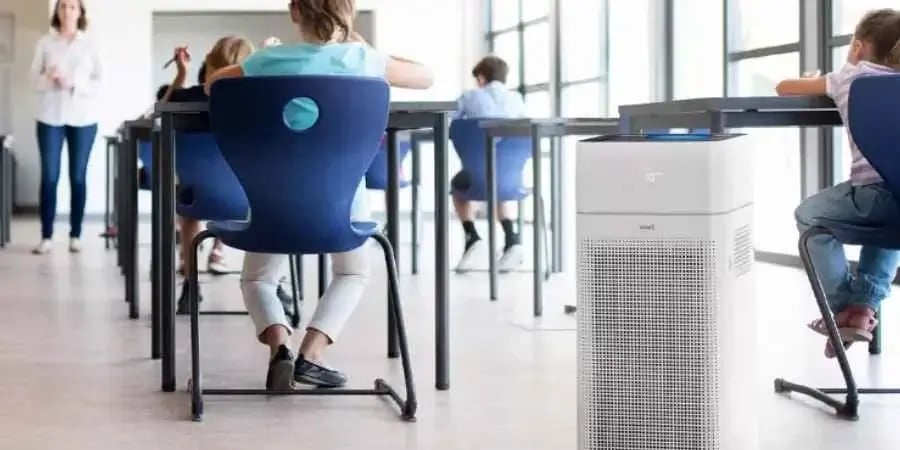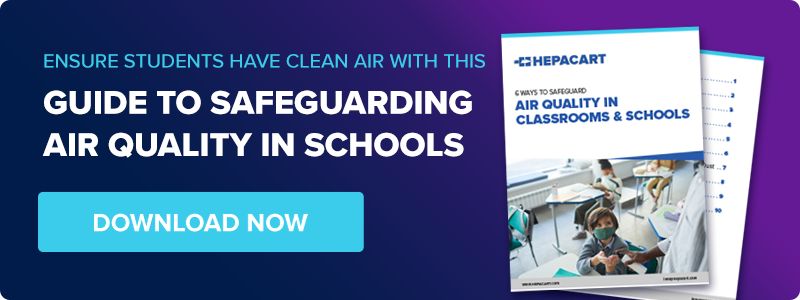Share this
Air Purifiers for Classrooms: 5 Tips for School Facility Managers
by HEPACART on Jan 31, 2023

Children and teenagers spend the majority of their week at school. What they are exposed to there will affect their health and learning ability. As a facility manager, you know that indoor air quality is one of the most important factors to consider when thinking about the health of your school's occupants. But when shopping for classroom air purifiers, it can be hard to know which system is the best fit. If you are looking for a new air purifier for classrooms in your school's facility, we have gathered some of the most important tips to keep in mind throughout the process.
Tips for Facility Managers When Purchasing Air Purifiers
Air purifiers for dust come in different sizes, features, and certifications that impact how the machine operates. Let's look at some features that should be considered during the buying process.
1. Know the Size You Need - Size of Machine vs. Size of Room
Investing in an industrial air purifier for classrooms is a fantastic idea. However, if you do not purchase one that is adequate for the size of your classroom, it may not perform to the highest standard. To ensure that all of the air throughout your facility is clean, you will need to understand which air purifiers are designed for areas of specific square feet. Typically, small air purifiers filter rooms up to 299 square feet, medium purifiers are perfect for rooms between 300 and 699 square feet, and large purifiers are designed for rooms between 700 and 1,900 square feet. Schools and universities will likely have vastly different-sized classrooms, offices, and common spaces. Be sure to select the correct size air purifier for the designated area.
2. Understand the Noise Level That Purifiers Put Out
Noise can cause unnecessary stress and decrease a student's performance. Excessive noise can be distracting and hinder students from learning. When you are looking for air purifiers for your classrooms, it is critical to consider the noise level for each type of air purifier. Different brands and models will put out a different level of noise. Some may be considerably loud and would be difficult to run during the day when students are trying to learn. Most air purifiers for dust come with a "quiet mode" to help eliminate unnecessary noise that can help increase a student's productivity.
3. Know Cleaning and Maintenance Costs
With any large air purifier, maintenance will likely be needed to ensure the device can run smoothly for years to come. However, the frequency and cleaning requirements will vary depending on your indoor air quality (IAQ) and air purifier type. If the IAQ is heavily polluted, more particles will be trapped in the filter in less time. This means that the filter will need to be replaced more frequently. Many HEPA filters will last for at least 6 months to a year. Some air purifiers will have an automatic indicator that will turn on when the filter needs to be replaced. Ideally, you will want a filter that can be replaced less frequently to help cut down on maintenance time and overhead costs.
4. Certifications and Warranties
With any air purifier for dust, understanding what kinds of credentials there are in the industry and which purifiers meet specific standards is important to ensure you are investing in a high-quality system. Systems that have been put through a level of testing and receive passing results will be more efficient than others. You may be able to find these certifications on the device's label, or a product may have more official documentation based on the type of certification it received.
One of the most annoying things is to invest in pricey equipment only to have it fail after a few years. Warranties are important to consider because they will ensure your device works properly for a specific amount of time and will likely replace it if there is an issue. Be sure to research devices to compare warranties and ensure you are covered in case anything happens to your air purifier shortly.
5. What Features Can be Beneficial to Have on the Purifier
While a baseline model can be sufficient, extra features may be useful in helping you maintain proper IAQ. Here are three standard features that you may want to consider for air purifiers for classrooms.
HEPA Filter: A HEPA filter is a type of pleated mechanical air filter. HEPA is an acronym, and the official definition of it from the U.S. Department of Energy is “high-efficiency particulate air filter.” This particular type of air filter can theoretically remove at least 99.97% of size 0.3 microns from the air, including dust, pollen, mold, bacteria, and any other airborne particles.
Air Change Per Hour: Air changes per hour is a way to measure how many times each hour outside air enters a space and is mixed and replaces old air from inside. The American Society of Heating, Refrigerating, and Air-Conditioning Engineers (ASHRAE) recommends that schools should have an air ventilation rate of 5-6 times per hour. This means outside air should enter a facility or room 5-6 times per hour.
Clean Air Delivery Rate (CADR): Clean air delivery rate is the volume at which filtered air that an air purifier or filter delivers clean air. The higher a CADR number the faster the unit can filter and does filter the air. This number is measured in cubic feet per minute, this number will be provided by the manufacturer. CADR provides the knowledge of how effective the air purifier you have, is.
Why Is It Important to Keep the Air Clean?
According to the Environmental Protection Agency (EPA), 50% of schools have self-reported poor air quality. Schools are a breeding ground for germs and viruses. When students are continuously exposed to poor air, it can greatly affect their health and learning ability. Coughing, sneezing, and respiratory problems are all consequences of poor indoor air quality. When sick, students cannot pay full attention to their teacher and even miss vital learning days.
Clean air promotes good health and a positive learning environment. By utilizing filtration devices, facility managers can work to eliminate small particles in the air that can be harmful for those in the classroom. Studies have shown that improved air quality can positively impact students' test scores. When schools prioritize IAQ, they prioritize their students' health and learning ability.
Take the Necessary Steps
Ultimately, every facility will need a different air purifier for classrooms. From budget to air quality, numerous factors can determine which purification system best fits your facility. If you are making IAQ a priority, you are already making strides to ensure good health and increased productivity.
With your occupant's health at the forefront of your mind, safeguarding indoor air quality should be a top priority. A practical, step-by-step strategy is needed to ensure you are making progress in obtaining clean air. To help you strategize how to secure proper IAQ in your facility, download a copy of our guide, 6 Ways to Safeguard Air Quality in Classrooms & Schools.

